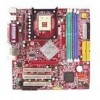MSI 865GM2-LS User Guide - Page 62
IDE Primary/Secondary Master/Slave PIO - sata driver
 |
UPC - 816909004168
View all MSI 865GM2-LS manuals
Add to My Manuals
Save this manual to your list of manuals |
Page 62 highlights
BIOS Setup IDE DMA Transfer Support This item is used to enable or disable the DMA transfer function of the IDE Hard Drive. The settings are: Enabled, Disabled. On-Chip Primary/Secondary PCI IDE The integrated peripherals controller contains an IDE interface with support for two IDE channels. Choose Enabled to activate each channel separately. Setting options: Disabled, Enabled. IDE Primary/Secondary Master/Slave PIO The four IDE PIO (Programmed Input/Output) fields let you set a PIO mode (0-4) for each of the four IDE devices that the onboard IDE interface supports. Modes 0 through 4 provide successively increased performance. In Auto mode, the system automatically determines the best mode for each device. The settings are: Auto, Mode 0, Mode 1, Mode 2, Mode 3, Mode 4. Primary/Secondary Master/Slave UDMA Ultra DMA/33 implementation is possible only if your IDE hard drive supports it and the operating environment includes a DMA driver (Windows 95 OSR2 or a third-party IDE bus master driver). If your hard drive and your system software both support Ultra DMA/33, Ultra DMA/ 66 and Ultra DMA/100 select Auto to enable BIOS support. The settings are: Auto, Disabled. **On-Chip Serial ATA Setting** On-Chip Serial ATA This setting is used to specify the SATA controller. Settings: Disable, Auto, Legacy Mode, Native Mode. If [Legacy Mode] is selected, PATA and SATA will be combined. If [Native Mode] is selected, PATA and SATA will both be enabled. If [Auto] is selected, PATA and SATA will be arranged by BIOS, and you will be able to see the IDE Device status listed in Standard COMS Features. 3-17















